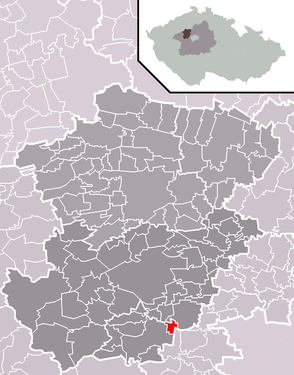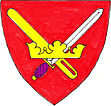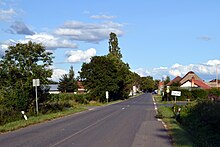Pavlov u Unhoště
| Pavlov | ||||
|---|---|---|---|---|
|
||||
| Basic data | ||||
| State : |
|
|||
| Region : | Středočeský kraj | |||
| District : | Kladno | |||
| Area : | 156 ha | |||
| Geographic location : | 50 ° 6 ' N , 14 ° 10' E | |||
| Height: | 387 m nm | |||
| Residents : | 191 (Jan. 1, 2019) | |||
| Postal code : | 273 51 | |||
| License plate : | S. | |||
| traffic | ||||
| Street: | Unhošť - Středokluky | |||
| Railway connection: | Prague – Chomutov | |||
| Next international airport : | Prague airport | |||
| structure | ||||
| Status: | local community | |||
| Districts: | 1 | |||
| administration | ||||
| Mayor : | Josef Kozel (as of 2013) | |||
| Address: | Lidická 16 273 51 Pavlov |
|||
| Municipality number: | 532711 | |||
| Website : | www.pavlov.cz | |||
| Location of Pavlov in the Kladno district | ||||

|
||||
Pavlov (German Paulow , 1939-1945 Paulhof ) is a municipality in the Czech Republic . It is located three kilometers northeast of Unhošť and belongs to the Okres Kladno .
geography
Pavlov is on the Unhošťská tabule . The Sulovický creek rises north of the village and the Dobrovízský creek to the east. On the northern edge of the village, the route of the expressway R 6 / E 48 between Nové Strašecí and Hostivice passes Pavlov. The Praha – Chomutov railway runs at the southern exit of the town . Prague Airport is to the east .
Neighboring towns are Dolany , Peklov, Hřebeč and Lidice in the north, Hostouň in the northeast, Jeneč , Litovice, Břve and Chýně in the southeast, Hájek , Červený Újezd , Svárov and Rymáň in the south, Unhošť in the southwest, Kyšice , Fialka and Braškov in the west and Pletený Újezd , Malé Přítočno and Velké Přítočno in the northwest.
history
The first written mention of a Vorwerkshof belonging to the Hostauner property of the Prague Cathedral Chapter St. Veit took place in 1519. In 1715 the farm belonged to an unspecified Hron who sold it to Theresia von Siegberg two years later. In 1726 Ferdinand Kustoš von Zubří and Lipka bought the farm and had it expanded to include a manor, which was then referred to as Nový dvůr . Kustoš gradually acquired the brewery in Unhošť, ten houses in Hostouň and the mill in Poteplí, and combined the property to form the Neuhof estate. In 1744 he sold the property to the Ursuline Convent in Prague's New Town . After the abolition of the monastery in the course of the Josephine reforms , Gut Neuhof became part of the religious fund in 1782. On October 30, 1787, the Hofkammer sold the estate to Anton Johann Wittek von Salzberg. He sold the small brewery in Unhošť to the town of Unhošť, but kept the brewing rights at Gut Neuhof. In 1799 Wittek von Salzberg sold the estate to the Prague citizen Leopold Paul. In the same year Paul had a castle built on the farm.
In 1801 Paul laid out the village of Paulow named after him on Gut Neuhof . In the vernacular the village was mostly called Nové Dvory . Paul placed the new village under the jurisdiction of the property and had it recorded in his land register. After Paul's death in 1812, his widow Anna inherited the estate. The following year she handed it over to the married couple Karl and Eva Hofmann, née Scheichl. From 1816 the city of Unhošť filed a lawsuit against Gut Neuhof and claimed the Paulow land for itself. The dispute was settled in 1828; thereafter, the town of 152 stripes 4 quarters and the estate 112 strikes 4 quarters of Paulow. As a result, the village fell under the administration of the city of Unhošť. Walburga Berger bought the estate on November 8, 1828. Between 1827 and 1830 the Prague – Lana horse-drawn tram was laid south of the village .
In 1843 the Landtäfliche Gut Neuhof comprised a usable area of 235 yoke 915 square fathoms exclusively for rustic reasons . Main source of income were the agriculture and fruit production, the Meierhof Neuhof managed the authorities themselves. For Good Paulow the village, 23 houses of belonging Hostaun as well as top-Wezděkau the single-mill Potepl ( Poteplí ). 509 Czech-speaking people lived on the estate, including 13 Jewish and two Protestant families of the Augsburg denomination . The village of Paulow / Pawlow , located on the old Karlsbader Strasse, consisted of 34 houses with 269 inhabitants, including three Jewish and two Protestant families. In the village there was an official castle, a dominical meierhof with a kitchen and ornamental garden as well as a dominikales brewery, which was not in operation. Off to the east on Karlsbader Strasse was the Zum Schwarzen Rössel inn . The parish was Hostaun. In 1848 Walburga Berger's husband Maximilian acquired the estate. Until the middle of the 19th century, Paulow was the administrative village of the Neuhof estate.
After the abolition of patrimonial formed Pavlov / Paulow 1850 a district of the town Unhošť in the district of Smíchov and judicial district Unhošť. The residents of Pavlov had elected their own local council with a mayor, which the Unhošť council did not recognize. The district administration Smíchov decided in February 1852 that the appointment of a mayor in Pavlov was reserved for the Unhošťer mayor. Maximilian Berger sold the Neuhof estate to Wenzel and Katharina Kratochvíl in 1860. In 1863, the Buschtěhrad Railway started operating on the Prague-Kladno railway line, which was built in place of the old horse-drawn tram . On the open field at the Black Knight's at the intersection of the railroad with the Karlsbaderstrasse emerged station Rossel ; it was later abandoned and replaced in 1934 by the train station in Pavlov. In 1869 Josef and Barbara Daneš bought the Neuhof estate. They had the dilapidated buildings renewed and in 1870 a new brewery was built on the Nový dvůr farm to produce Novodvorské pivo beer . At that time Pavlov consisted of 39 houses with 291 residents. After the death of his parents in 1883 Viktor Daneš took over the estate. In 1890 the village had grown to 42 houses and had 338 inhabitants. In 1893 Pavlov was assigned to the Kladno District. The volunteer fire brigade was founded in 1897. In 1901 Pavlov broke away from Unhošť and formed its own community. The Daneš heirs sold the Neuhof estate with the brewery to Jan and Karel Kubíček in 1918; The next owner was Josef Vinař from 1923 and then his son of the same name. In 1932 Pavlov including Nový Dvůr had 309 inhabitants. In 1929 the place received a bus connection, in the same year it was connected to the electricity network. During the German occupation , the village was given the German name Paulhof . In 1942 the brewery ceased operations. The 1949 census counted 58 houses with 72 apartments and 254 residents in Pavlov. In 1950 the landowner Josef Vinař jun. expropriated and the Nový Dvůr estate attached to the Unhošť state estate. On the occasion of the 5th anniversary of the liberation, a mighty memorial stone was placed in the park. The Josef Vinař family was forcibly relocated to Dolní Bezděkov in 1951, the following year the Josef Kozel family was relocated to Zbuzany and the Karel Land family to Pazderna. In 1963, 14 hundred-year-old linden trees were felled to build a footpath on the road to Hostouň. In 1967 the castle was transferred to the Local National Committee, which used it as a municipal office, library, youth club, laundry shortage and for residential purposes. In 1980 there were 170 people in 69 households in the village. In 1988 it was decided to incorporate Pavlov into Unhošť on January 1, 1990. Due to the social changes after the Velvet Revolution , the planned incorporation became obsolete again. On the occasion of the 110th birthday of the first Czechoslovak consul in Sydney, the community set up a memorial for Jiří Viktor Daneš in 1990 in cooperation with the Czechoslovak-Australian Society. This was closed after the restitution of the property in 1992 and the exhibits were stored in the Melicharovo vlastivědné muzeum Unhošť. In 1993 a new municipal office was established. In 1999 the construction of the R 6 expressway began north of the village , and in 2008 the section was opened to traffic. In 2001 Pavlov celebrated its 200th anniversary, on this occasion the municipality received a coat of arms and a banner.
Community structure
No districts are shown for the municipality of Pavlov. The Nový Dvůr ( Neuhof ) location belongs to Pavlov .
Attractions
- Nový Dvůr Castle, built 1799–1801 with elements of classicism and empire style. After the expropriation in 1950 it served as a municipal office. The entire estate was returned to the descendants of Josef Vinař in 1992, who sold it to various owners. Petr Miškovský bought the chateau and had renovation work carried out.
Sons and daughters of the church
- Jiří Viktor Daneš (1880–1928), geographer, world traveler and diplomat
Web links
Individual evidence
- ↑ Český statistický úřad - The population of the Czech municipalities as of January 1, 2019 (PDF; 7.4 MiB)
- ↑ Johann Gottfried Sommer : The Kingdom of Bohemia. Volume 13: Rakonitz Circle. Ehrlich, Prague 1845, pp. 243–245 .




